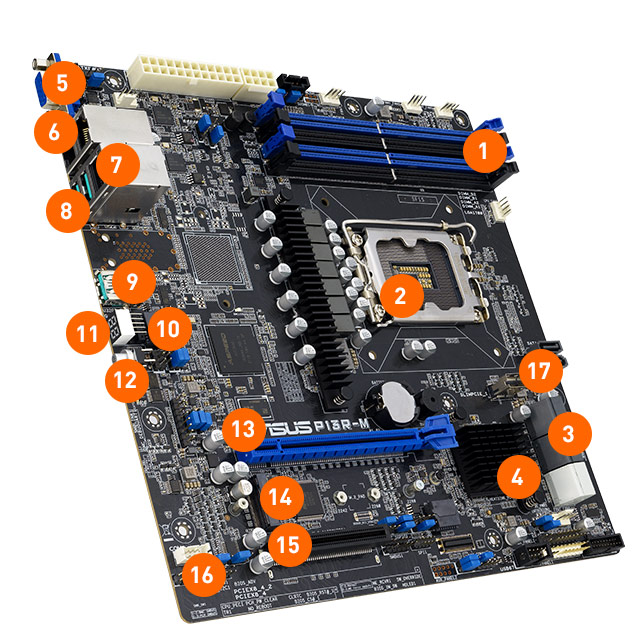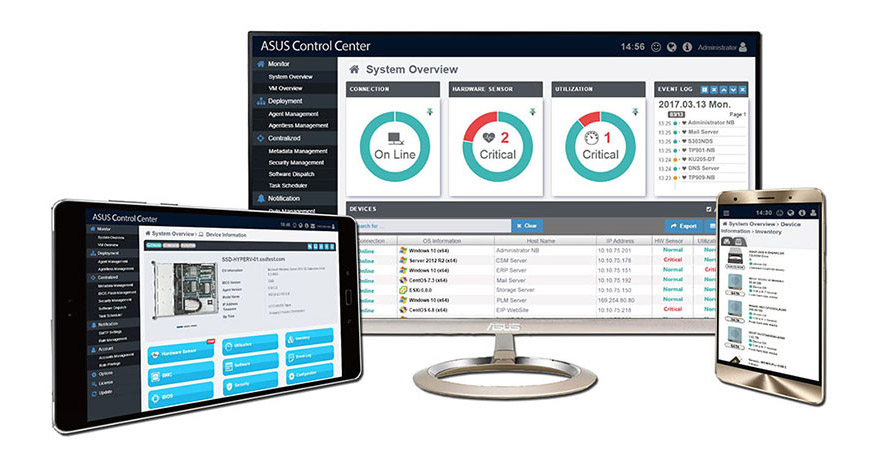Up to
8
cores
Faster storage, graphics and networking capabilities PCI Express® (PCIe®) 5.0 delivers 32GT/s bandwidth, which is twice the speed of PCIe 4.0, and offers lower power consumption, better land scalability and backwards compatibility. ASUS servers are PCIe 5.0 ready with scalability design to satisfy the increasing workloads for modern data center.



14 DIMM up to 128GB
DDR5 4400 ECC UDIMM
2Intel® LGA1700 Socket
38 x SATA 6Gb/s ports
4Intel® C262 Chipset
5Internal VGA header
6Dual Intel® I210AT LAN
7Dedicated Management LAN
82 x USB 3.2 Gen 2
91 x USB 3.2 Gen2
10Onboard ASMB11-iKVM
11Q code
12Rear Power Button
13PCI-E x16 (Gen5 x 16Link)
141x M.2 Socket, up to 2280
15PCI-E x8 (Gen4 x4 Link)
16TPM header
17SlimSAS port
Designed for small- to medium-sized businesses (SMBs) and cloud-service providers, offering robust and secure solutions. These processors support up to eight cores and 16 threads, with a maximum frequency of 5.6 GHz and a 95 W TDP, ensuring rapid data processing and application responsiveness. They support up to 128 GB of DDR5 4400 MT/s memory (Intel Xeon E-2400) or up to 4800 MT/s memory (Intel Xeon 6300) and PCIe 5.0 interfaces, providing server-grade 24/7 reliability for business-critical services and customer data, and cost-effective performance for entry-level bare-metal cloud services.

Up to
8
cores
Up to
95W
TDP
Up to
20-lane
16 x PCIe 5.0 and 4 x PCIe 4.0

ASUS P13R-M is equipped with three USB 3.2 Gen 2 ports on its rear I/O panel. These high-speed connections offer rapid data-transfer speeds of up to 10 Gbps, for fast, efficient and reliable file transfers. These sockets are also backward compatible, ensuring seamless connectivity with a wide range of USB devices.

With dual onboard LAN powered by an Intel I210AT Ethernet controller, P13R-M server motherboards provide business-grade connectivity and support high-density, high-bandwidth, low-latency access-layer networks to ensure faster transfers of large-size files used in data-intensive applications.
P13R-M features an embedded iKVM module and is optionally equipped with ASUS Control Center, offering comprehensive out-of-band and in-band management features tailored for small and mid-size businesses. The embedded ASUS ASMB11-iKVM module supports remote BIOS updates, fan control, standalone KVMs, video recording and BSOD capture, providing around-the-clock remote monitoring and diagnostics. This functionality remains accessible even if the operating system is down or offline, through a user-friendly web-based graphical interface compatible with all major browsers. ASUS Control Center (ACC) further enhances IT infrastructure management, centralizing and integrating monitoring and control for ASUS commercial products, including servers, workstations, and digital signage. ACC enables remote BIOS updates, mobile device system monitoring, and simplified server management through one-click software updates and dispatching.
Learn more about ASUS Control Center

ASUS P13R-M server motherboards integrate PFR FPGA as the platform Root-of-Trust solution for firmware resiliency to prevent from hackers from gaining access to infrastructure. ASUS security solutions are fully compliant with the 2018 National Institute of Standards and Technology (NIST) SP 800 193 specification.
In addition, all P13R-M server motherboards servers also include support Trusted Platform Module 2.0 (TPM 2.0) to secure hardware through integrated cryptographic keys and offer regular firmware update for vulnerabilities.
The TPM-M and TPM SPI difference and supported product list
* Platform Firmware Resilience (PFR) module must be specified at time of purchase and is factory-fitted. It is not for sale separately.
